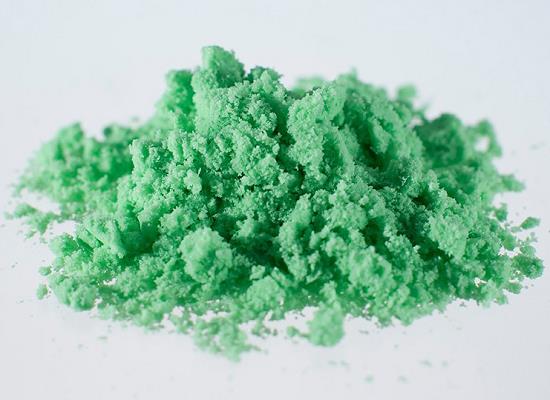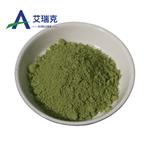Nickel(II) Hydroxide: Applications in Metal Nanoparticles Formation and Foam Synthesis of its Nanoflakes
Jul 29,2024
General Description
Nickel(II) hydroxide can be as a precursor for synthesizing metallic nickel nanoparticles and mesoporous nanoflakes. Various characterization techniques, including X-ray diffractometry and electron microscopy, are employed to analyze the structural and morphological properties of Nickel(II) hydroxide and its derivatives. A foam synthesis method enhances the formation of mesoporous Nickel(II) hydroxide nanoflakes, which exhibit exceptional electrocatalytic activity, particularly in methanol oxidation, significantly surpassing conventional Nickel(II) hydroxide. The findings highlight the potential of Nickel(II) hydroxide in catalysis and materials science, paving the way for optimized synthesis approaches and tailored applications.

Figure 1. Nickel(II) Hydroxide
Applications in Metal Nanoparticles Formation
Formation Process and Experimental Setup
Nickel(II) hydroxide serves as a precursor for synthesizing metallic nickel nanoparticles through reduction processes, particularly under hydrogen gas environments. Initially, Nickel(II) hydroxide is synthesized by reacting nickel (II) nitrate hexahydrate with sodium hydroxide (NaOH), following controlled deposition conditions. The resulting hydroxide precipitates undergo a series of washing treatments to enhance powder dispersion. Techniques such as centrifugation, ultrasonic treatment, and decantation are employed to purify and refine the Nickel(II) hydroxide particles prior to reduction.
Characterization Techniques and Structural Analysis
A comprehensive characterization approach is employed to analyze the structural and morphological properties of both Nickel(II) hydroxide and the resulting metallic nickel nanoparticles. Techniques such as X-ray diffractometry provide insight into crystal structure, while transmission electron microscopy offers detailed images of nanoparticle morphology and size distribution. Low-temperature nitrogen adsorption studies reveal surface area and porosity changes, crucial for understanding catalytic applications. Infrared and Raman spectroscopies, alongside X-ray photoelectron spectroscopy, contribute further to elucidating chemical composition and surface states, aiding in the development of a detailed model for the aggregation structure of Nickel(II) hydroxide post-deposition.
Model of Nickel Nanoparticle Formation
Based on experimental data and structural analyses, a theoretical model is constructed to describe the formation process of metallic nickel nanoparticles from nickel hydroxide. This model estimates the number of Nickel(II) hydroxide particles necessary to nucleate and grow into a single nickel nanoparticle. Factors influencing particle size and morphology are systematically explored, highlighting the role of deposition conditions and subsequent washing treatments in controlling final nanoparticle characteristics. Insights gained from this study not only advance fundamental understanding but also pave the way for optimizing synthesis protocols towards tailored applications in catalysis, sensing, and other emerging fields.
In conclusion, nickel(II) hydroxide emerges as a versatile precursor for generating metallic nickel nanoparticles, leveraging its controllable synthesis pathways and subsequent characterization techniques to tailor nanoparticle properties for specific applications. This systematic approach not only enhances fundamental knowledge of nanoparticle formation mechanisms but also underscores the potential for practical advancements in nanotechnology and materials science. 1
Foam Synthesis of Nanoflakes
Synthesis of Nickel(II) Hydroxide Nanoflakes
The foam synthesis of mesoporous two-dimensional Nickel(II) Hydroxide (Ni/Ni(OH)2) nanoflakes involves a unique dual templating method combining surfactant self-assembled thin-films and hydrogen bubble foam. This method utilizes sodium borohydride as a reducing agent, which produces hydrogen bubbles that act as dynamic templates during the synthesis process. The surfactant molecules arrange themselves into a structured thin-film at the liquid-air interface, effectively controlling the morphology and porosity of the resulting Nickel(II) Hydroxide nanoflakes. The physical and chemical characterizations of these nanoflakes reveal an amorphous mesoporous structure with a remarkably high specific surface area of 165 m2/g. The unique structure of the Nickel(II) Hydroxide nanoflakes is crucial for their enhanced performance in catalytic applications, primarily due to the increased surface area that facilitates higher catalytic activity. 2
Electrocatalytic Properties of Nickel(II) Hydroxide Nanoflakes
Electrochemical evaluations of the Nickel(II) Hydroxide nanoflakes have shown outstanding electrocatalytic activity, especially in the electrooxidation of methanol within an alkaline environment. The methanol oxidation mass activity recorded for these nanoflakes is significantly higher, achieving a peak of 545 A/cm2 gcat at 0.6 V vs. Ag/AgCl. This is more than five times the activity exhibited by conventional bare-Nickel(II) Hydroxide. Furthermore, the Nickel(II) Hydroxide nanoflakes exhibit a lower charge transfer resistance of only 10.4 Ω and maintain a stable oxidation current density of 625 A/cm2 gcat at 0.7 V vs. Ag/AgCl. The impressive performance of the Nickel(II) Hydroxide nanoflakes is attributed to the efficient charge transfer capabilities and methanol transport dynamics facilitated by the mesoporous 2D architecture, which allows for better accessibility to Ni2+/Ni3+ active sites throughout the catalyst layer, thereby enhancing overall catalytic efficacy. 2
Reference
1. Sidorova EN, Dzidziguri EL, Vinichenko YP, et al. Metal Nanoparticles Formation from Nickel Hydroxide. Materials (Basel). 2020; 13(20): 4689.
2. Bamuqaddam AM, Aladeemy SA, Ghanem MA, Al-Mayouf AM, Alotaibi NH, Marken F. Foam Synthesis of Nickel/Nickel (II) Hydroxide Nanoflakes Using Double Templates of Surfactant Liquid Crystal and Hydrogen Bubbles: A High-Performance Catalyst for Methanol Electrooxidation in Alkaline Solution. Nanomaterials (Basel). 2022; 12(5): 879.
- Related articles
- Related Qustion
Vitamin A Palmitate is a vital form of vitamin A, an essential nutrient for numerous biological functions, and immune system performance.....
Jul 29,2024APIIsoprinosine enhances immune response, inhibits viral replication, and shows efficacy against herpes simplex virus, suggesting broad antiviral potential.....
Jul 29,2024APINICKEL(II) HYDROXIDE
12054-48-7You may like
NICKEL(II) HYDROXIDE manufacturers
- Nickel(ii) hydroxide
-

- $0.00 / 1Kg
- 2024-03-13
- CAS:12054-48-7
- Min. Order: 1Kg
- Purity: 99.9%
- Supply Ability: 20 tons
- NICKEL(II) HYDROXIDE
-

- $7.00 / 1kg
- 2019-07-06
- CAS: 12054-48-7
- Min. Order: 1kg
- Purity: 99%
- Supply Ability: 100kg




